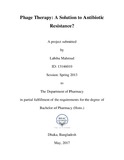| dc.contributor.advisor | Kabir, Eva Rahman | |
| dc.contributor.advisor | Hossain, Zulfiquer | |
| dc.contributor.author | Mahmud, Labiba | |
| dc.date.accessioned | 2018-02-08T06:13:41Z | |
| dc.date.available | 2018-02-08T06:13:41Z | |
| dc.date.copyright | 2017 | |
| dc.date.issued | 2017-05-08 | |
| dc.identifier.other | ID 13146010 | |
| dc.identifier.uri | http://hdl.handle.net/10361/9422 | |
| dc.description | This project report is submitted in partial fulfilment of the requirements for the degree of Bachelor of Pharmacy, 2017. | en_US |
| dc.description | Cataloged from PDF version of project report. | |
| dc.description | Includes bibliographical references (page 46-49). | |
| dc.description.abstract | Antibiotic resistance has increased immensely within the last few decades rendering many widely used medicines obsolete. This has led to interest in alternative methods of treatment for infectious diseases. Bacteriophage therapy can provide a well needed solution to this problem. Phages are viruses which infect bacteria and therefore express bacteriocidal properties. They are highly selective of the bacteria they infect and as a result do not harm host cells. Since the discovery of phages in 1915 there has been an increase in the amount of research carried out to develop a therapeutic use. Phage life cycles are better understood now and their ability to adapt to changes in their host bacterial characteristics, reduces chances of phage resistance. Phage therapy is being developed by various companies for the past few decades, with most products pending clinical trials or market approval. The manufacture of phages include steps beginning from genomic identification of phages, isolation and purification and finally to formulation development. Manufacture of phages is different from manufacture of other therapeutic products as it is a living entity and needs very precise conditions for production. Presently there are treatment options which have shown effectivity when administered as a solid dosage form, topically and nasally. Due to the nature of phage therapy it has the potential to cure diseases in a wide range of patients suffering from various ailments which prevents use of antibiotics to cure diseases and may be the solution to the present global crisis of antibiotic resistance. | en_US |
| dc.description.statementofresponsibility | Labiba Mahmud | |
| dc.format.extent | 54 pages. | |
| dc.language.iso | en | en_US |
| dc.publisher | BRAC University | en_US |
| dc.rights | BRAC University project reports are protected by copyright. They may be viewed from this source for any purpose, but reproduction or distribution in any format is prohibited without written permission. | |
| dc.subject | Phage therapy | en_US |
| dc.subject | Antibiotic resistance | en_US |
| dc.subject | Bacteriophage therapy | en_US |
| dc.title | Phage therapy: A solution to antibiotic resistance? | en_US |
| dc.type | Project report | en_US |
| dc.contributor.department | Department of Pharmacy, BRAC University | |
| dc.description.degree | B. Pharmacy. | |

